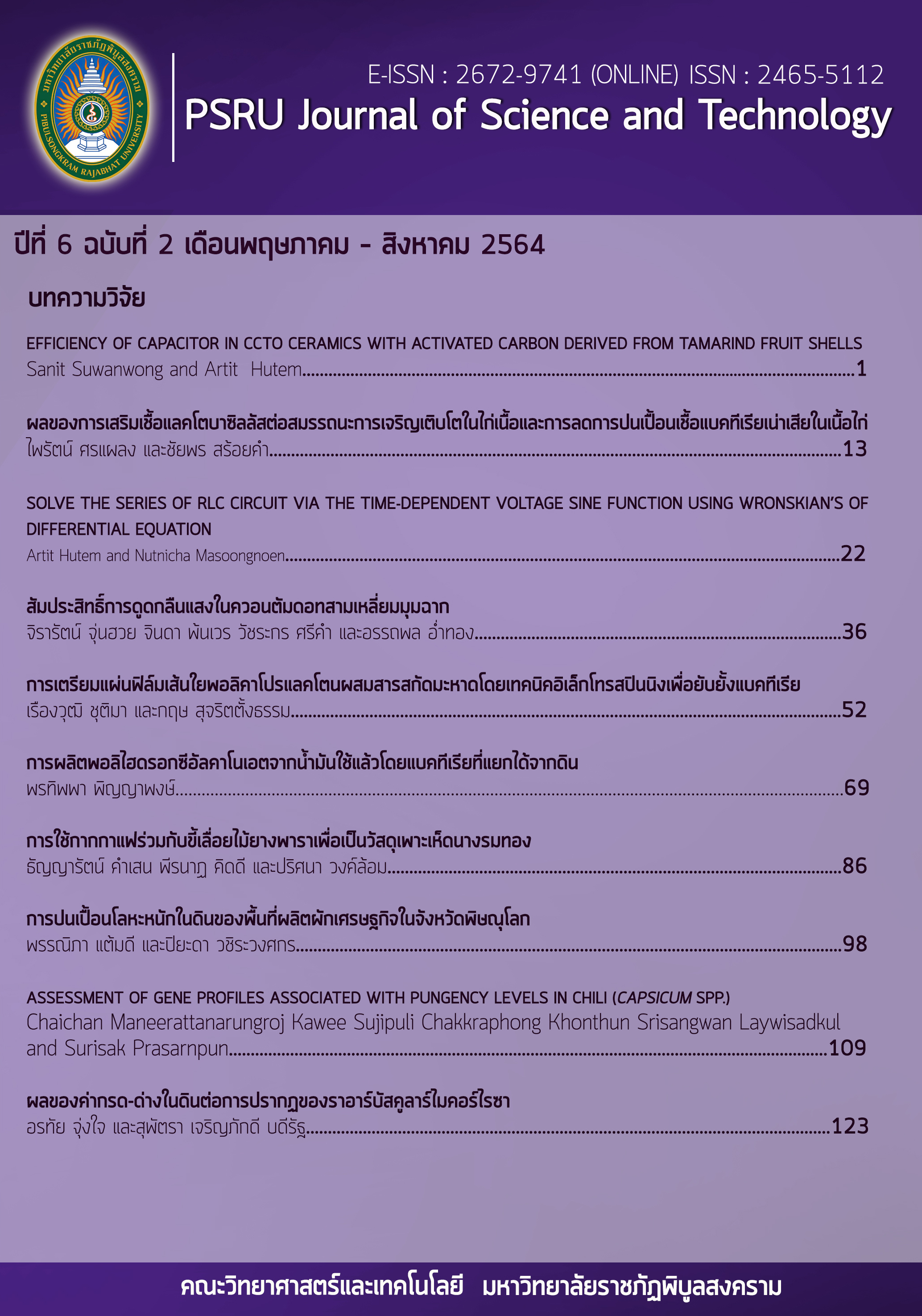PRODUCTION OF POLYHYDROXYALKANOATE FROM USED COOKING OIL BY SOIL-ISOLATED BACTERIA
Keywords:
Polyhydroxyalkanoate, Soil contaminated with polycyclic aromatic hydrocarbons, Soil-isolated bacteria, Used cooking oilAbstract
Polyhydroxyalkanoate (PHA) are synthesized and accumulated in bacterial cells to serve as an energy source. The objective of this research was to select bacteria capable of producing high PHA from soil contaminated with polycyclic aromatic hydrocarbons and to study the optimum conditions for producing PHA. Soil samples of 3 areas: the grass burning area, area contaminated with engine oil and area contaminated with agricultural chemicals were used for screening bacteria through Mineral Salt Medium (MSM) with 1%w/v glucose as a carbon source. PHA synthesis was preliminary tested by staining cells with Sudan Black B. It was found that 4 bacterial isolates were selected from 91 bacterial isolates. SCODw0.2 isolated from soil contaminated with engine oil was able to produce the highest PHA at 0.605 g/L (55.0% of dry cell weight). The optimum conditions of PHA synthesis from used cooking oil by SCODw0.2 were investigated. It was found that this isolate bacterium could produce highest PHA about 0.879 g/l (68.9% of dry cell weight) when cultured in MSM medium containing used cooking oil and ammonium sulphate as carbon source and nitrogen source, respectively, at ratio of 100 : 1, pH 7 and incubated at 35 °C for 60 hours. The composition of PHA that synthesized by bacteria when analyzed by gas chromatography-mass spectrometry was consisted of 3-hydroxydodecanoate, 3-hydroxytetradecanoate and others were 72.94, 12.92 and 14.14 %, respectively.
References
ดุษฎี มูลดา, สุดารัตน์ แซ่โจว, สุทธิชา ณ ระนอง ธรรมสิทธิรงค์, และอานนท์ ธรรมสิทธิรงค์. (2560). การคัดแยกและศึกษาสภาวะที่เหมาะสมในการผลิต PHA จากเชื้อบาซิลลัส. วารสารวิทยาศาสตร์บูรพา, 22, 288-298.
วิมล ชอบชื่นชม, ลุกมาน สีอรี, และณัฐพล ถนัดช่างแสง. (2558). การแยกและการคัดกรองจุลินทรีย์ที่สามารถสังเคราะห์ Polyhydroxybutyrate P(3HB) จากตัวอย่างดินและน้ำในประเทศไทยโดยใช้น้ำตาลกลูโคสเป็นแหล่งคาร์บอน. ใน การประชุมวิชาการระดับชาติมหาวิทยาลัยรังสิตประจำปี 2588 (น. 101-108). กรุงเทพฯ: มหาวิทยาลัยรังสิต.
โสภา ชินเวชกิจวานิชย์. (2547). อิทธิพลของอุณหภูมิต่อการผลิตพีเอชเอเชื้อผสมโดยน้ำเสีย. (วิทยานิพนธ์ปริญญาดุษฏีบัณฑิต) จุฬาลงกรณ์มหาวิทยาลัย คณะวิศวกรรมศาสตร์.
อัมทิกา เมืองวงษ์. (2553). การผลิตพอลิไฮดรอกซีแอลคาโนเอตโดยใช้ของเสียอินทรีย์จากกระบวนการผลิตไบโอดีเซล. (วิทยานิพนธ์ปริญญามหาบัณฑิต) จุฬาลงกรณ์มหาวิทยาลัย คณะวิทยาศาสตร์ สาขาวิชาจุลชีววิทยาทางอุตสาหกรรม.
Akaraonye, E., Keshavarz, T., & Roy, I. (2010). Production of polyhydroxyalkanoates: the future green materials of choice. Journal of Chemical Technology and Biotechnology, 85, 732-743.
Alvi, S., Thomas, S., Sandeep, K.P., Kalaalvirikkal, N.J.V., & Yaragalla, S. (2014). Polymers for packaging application. New Jersey: Apple Acaademic Press.
Bose, S.A., Raja, S., Jeyaram, K., Arockiasamy, S., & Velmurugan, S. (2020). Investigation of fermentation condition for production enhancement of polyhydroxyalkanoate from cheese whey by Pseudomonas sp. Journal of Microbiology, Biotechnology and Food Sciences, 9(5), 890-989.
Bhuwal, A.K., Singh, G., Aggarwal, N.K., Goyal, V., & Yadav, A. (2013). Isolation and screening of polyhydroxyalkanoates producing bacteria from pulp, paper, and cardboard industry wastes. International Journal of Biomaterials, 2013. http://dx.doi.org/10.1155/2013/752821.
Chen, G.Q. (2009). A microbial polyhydroxyalkanoates (PHA) based bio- and materials industry. Chemical Society Reviews, 38, 2434-2446.
Chhetri, A.B., Watts, C.K., & Islam, R.M. (2008). Waste cooking oil as an alternate feedstock for biodiesel production. Energies, 1, 3-18.
Du, G., Si, Y., & Yu, J. (2001). Inhibitory effect of medium-chain-length fatty acids on synthesis of polyhydroxyalkanoates from volatile fatty acids by Ralstonia eutropha. Biotechnology Letters, 23, 1613-1617.
Haba, E., Vidal Mas, J., Bassas, M., Espuny, M.J., Llorens, J., & Manresa, A. (2007). Poly 3-(hydroxy-alkanoates) produced from oily substrates by Pseudomonas aeruginosa 47T2 (NCBIM 40044): effect of nutrients and incubation temperature on polymer composition. Biochemical Engineering Journal, 35, 99-106.
Kedia, G., Passanha, P., Dinsdale, R.M., Guwy, A.J., & Esteves, S.R. (2014). Evaluation of feeding regimes to enhance PHA production using acetic and butyric acids by a pure culture of Cupriavidus necator. Biotechnology and Bioprocess engineering, 19(6), 989-995.
Kessler, B., & Witholt, B. (2001). Factors involved in the regulatory network of polyhydroxyalkanoate metabolism. Journal of Biotechnology, 86, 97-104.
Koller, M., Atlic, A., Dias, M., Reiterer, A., & Braunegg, G. (2010). Plastics from bacteria: natural functions and application. Berlin/Heidelberg: Springer.
Lee, S.Y., Choi, J.L., & Wong, H.H. (1999). Recent advances in polyhydroxyalkanoate production by bacterial fermentation. International Journal of Biological Macromolecules, 25, 31-36.
Pal, A., Prabhu, A., Kumar, A.A., Rajagopal, B., Dadhe, K., Ponnamma V., & Shivakumar, S. (2009). Optimization of process parameters for maximum poly--hydroxybutyrate (PHB) production by Bacillus thuringiensis IAM 12077. Polish Journal of Microbiology, 58, 149-154.
Raza, Z.A., Abid, S., & Banat, I.M. (2018). Polyhydroxyalkanoates: Characteristics, production, recent developments and applications. International Biodeterioration & Biodegradation, 126, 45-56.
Saadoun, I. (2002). Isolation and characterization of bacteria from crude petroleum oil contaminated soil and their potential to degrade diesel fuel. Journal of Basic Microbiology, 42, 420-428.
Samuel, M.M., Betty, M.N., Kasili, R., Edward, K.M. & Naumih, N.M. (2019). Production of polyhydroxy-alkanoates by hydrocarbonaclastic bacteria. African Journal of Biotechnology, 18(17), 352-364.
Song, H.J., Jeon, C.O., Choi, M.H., Yoon, S.C., & Park, W. (2008). Polyhydroxyalkanoate (PHA) production using waste vegetable oil by Pseudomonas sp. Strain DR2. Journal of Microbiology and Biotechnology, 18, 1408-1415.
Srilakshmi, S., & Ramachandra, R.V.S.C. (2012). Studies on screening isolation and molecular characterization of PHB producing Staphylococcus spp. International Journal of Integrative sciences, Innovation and Technology Section B, 1, 24-31.
Tan, G.A., Chen, C-L., Li, L., Ge, L., Wang, L., Razaad, I.M.N., Li, Y., Zhao, L., Mo, Y., & Wang, J-Y. (2014). Start a research on biopolymer polyhydroxyalkanoate (PHA): A Review. Polymer, 6, 706-754.
Thuithaisong, C., Parkpian, P., Shipin, O.V., Shrestha, R.P., Naklang, K., Delaune, R.D., & Jugsujinda, A. (2011). Soil-quality indicators for predicting sustainable organic rice production. Communications in Soil Science and Plant Analysis, 42, 548-568.
Verlinden, R.A.J., Hill, D.J., Kenward, M.A., Williams, C.D., & Radecka, I. (2007). Bacterial synthesis of biodegradable polyhydroxyalkanoates. Journal of Applied Microbiology, 102, 1437-1449.
Downloads
Published
How to Cite
Issue
Section
License
กองบรรณาธิการขอสงวนสิทธิ์ในการปรับปรุงแก้ไขตัวอักษรและคำสะกดต่างๆ ที่ไม่ถูกต้อง และต้นฉบับที่ได้รับการตีพิมพ์ในวารสาร PSRU Journal of Science and Technology ถือเป็นกรรมสิทธิ์ของคณะวิทยาศาสตร์และเทคโนโลยี มหาวิทยาลัยราชภัฏพิบูลสงคราม และ
ผลการพิจารณาคัดเลือกบทความตีพิมพ์ในวารสารให้ถือมติของกองบรรณาธิการเป็นที่สิ้นสุด







